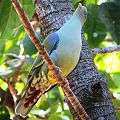African green pigeon
| African green pigeon | |
|---|---|
.jpg) | |
| T. c. delalandii in the Kruger Park | |
| Scientific classification | |
| Kingdom: | Animalia |
| Phylum: | Chordata |
| Class: | Aves |
| Order: | Columbiformes |
| Family: | Columbidae |
| Genus: | Treron |
| Species: | T. calvus |
| Binomial name | |
| Treron calvus (Temminck, 1811) | |
The African green pigeon (Treron calvus) is a species of bird in the family Columbidae, and one of 5 green pigeon species in the Afrotropics. The species has a wide range in Sub-Saharan Africa with around 17 accepted races.[2]
Description
Adult birds have maroon shoulder patches (olive in immatures) and rufous undertail coverts. They reach a length of 25–28 cm.
Range
They may occur and breed in high densities but are prone to regular local movements. Their range includes Angola, Benin, Botswana, Burkina Faso, Burundi, Cameroon, Central African Republic, Chad, Republic of the Congo, Democratic Republic of the Congo, Ivory Coast, Equatorial Guinea, Ethiopia, Gabon, Gambia, Ghana, Guinea, Guinea-Bissau, Kenya, Liberia, Malawi, Mali, Mauritania, Mozambique, Namibia, Niger, Nigeria, Rwanda, São Tomé and Príncipe, Senegal, Sierra Leone, Somalia, South Africa, South Sudan, Swaziland, Tanzania, Togo, Uganda, Zambia and Zimbabwe.
Habits
As with others in their genus, they frequent tree canopies where their parrot-like climbing ability[3] enable them to reach fruit, but rarely also forage on the ground. Their call is a series of flowing whistles, rendered as ‘thweeeloo, thweeeoo’. They inhabit riparian forest, woodland and savanna, where they associate with fruiting trees, especially wild fig (Ficus) species, including Ficus sycomorus and Ficus sur, and in cities the ornamental Chinese banyan. They also take fruit of Saffrons (Cassine spp.), Jacket plum (Pappea capensis), Buffalo thorn (Ziziphus mucronata), Water berry (Syzygium cordatum) and Jackalberry (Diospyros mespiliformis). They may also feed on exotic Loquats and Mulberries, or on carrion by occasion.
Nesting
They nest in a tree fork that offers an adequate vantage point of their surrounds. The nest is a weak platform of sticks, collected by the male and arranged by the female.[4] Nesting may take place in any month of the year, though mostly in summer. 1-2 eggs are laid that hatch in 13–14 days. Chicks leave the nest at about 12 days.
Pictures
-

Close-up of the head -
_in_fruit-bearing_tree.jpg)
T. c. nudirostris feeding on wild figs, Gambia
-

T. c. glaucus feeding in Ficus microcarpa, South Africa
-

T. c. glaucus, showing chestnut undertail-coverts
References
- ↑ BirdLife International (2012). "Treron calvus". IUCN Red List of Threatened Species. Version 2013.2. International Union for Conservation of Nature. Retrieved 26 November 2013.
- ↑ "African Green-pigeon (Treron calva)". Internet Bird Collection. Lynx Edicions. Retrieved 22 October 2012.
- ↑ Gerhard Rösler: Die Wildtauben der Erde – Freileben, Haltung und Zucht, Verlag M. & H. Schaper, Alfeld-Hannover 1996, ISBN 3-7944-0184-0
- ↑ Video of nesting behaviour, The Internet Bird Collection
External links
- (African) green pigeon - Species text in The Atlas of Southern African Birds
